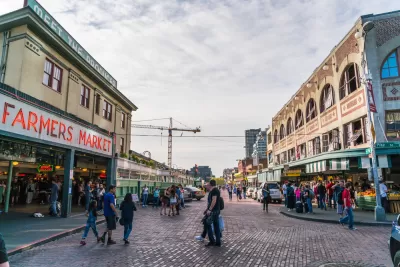The increased demand for walkable urban spaces could make them more and more exclusionary if cities don’t pursue policies to limit displacement and boost affordability.

As more people recognize and seek out the benefits of compact, walkable, communities, the desirability of these areas and the consequent rising housing costs threaten to put them out of reach for many American households without concerted efforts on the part of policymakers to preserve affordable housing, according to a report from Smart Growth America. Maria Rachal outlines the report’s findings for Smart Cities Dive.
While early pandemic pundits predicted the ‘death’ of urban areas, recent trends show that people—perhaps more than ever—value the benefits of compact development and easily accessible amenities and services. But “Demand drives up costs and can reduce low- and moderate-income households’ opportunity to live in highly walkable areas,” the report warns.
“The organizations that produced the report stated that 19.1% of the total U.S. real GDP and 6.8% of the nation’s population are in walkable urban places that cover 1.2% of the total land mass of the top 35 metro areas.” Yet many localities prevent dense development through their zoning codes. “To spur walkability and equitable access to walkable areas, cities can advance zoning reform, foster non-car transportation options, preserve and invest in affordable housing, and plan for walkable neighborhoods to be resilient to climate impacts, the report states.”
FULL STORY: Walkable urban areas are popular but have an affordability problem: report

Alabama: Trump Terminates Settlements for Black Communities Harmed By Raw Sewage
Trump deemed the landmark civil rights agreement “illegal DEI and environmental justice policy.”

Planetizen Federal Action Tracker
A weekly monitor of how Trump’s orders and actions are impacting planners and planning in America.

Why Should We Subsidize Public Transportation?
Many public transit agencies face financial stress due to rising costs, declining fare revenue, and declining subsidies. Transit advocates must provide a strong business case for increasing public transit funding.

Understanding Road Diets
An explainer from Momentum highlights the advantages of reducing vehicle lanes in favor of more bike, transit, and pedestrian infrastructure.

New California Law Regulates Warehouse Pollution
A new law tightens building and emissions regulations for large distribution warehouses to mitigate air pollution and traffic in surrounding communities.

Phoenix Announces Opening Date for Light Rail Extension
The South Central extension will connect South Phoenix to downtown and other major hubs starting on June 7.
Urban Design for Planners 1: Software Tools
This six-course series explores essential urban design concepts using open source software and equips planners with the tools they need to participate fully in the urban design process.
Planning for Universal Design
Learn the tools for implementing Universal Design in planning regulations.
Caltrans
Smith Gee Studio
Institute for Housing and Urban Development Studies (IHS)
City of Grandview
Harvard GSD Executive Education
Toledo-Lucas County Plan Commissions
Salt Lake City
NYU Wagner Graduate School of Public Service





























